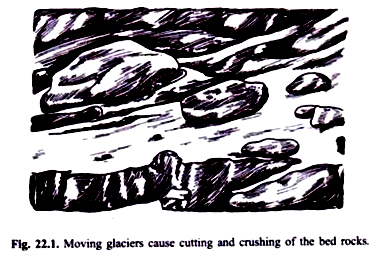It is a process in which the massive consolidated rocks are broken down into smaller particles and eventually into the individual minerals of which they are composed.
As a result of Lathering the rock fragments and the minerals are changed to new minerals either by alteration or by complete chemical changes.
Weathering processes are distinguished into the following three types on the basis of nature of agencies which bring about weathering:
(1) Physical weathering,
(2) Chemical weathering, and
(3) Biological weathering or biogeochemical weathering.
1. Physical Weathering:
Physical weathering of rocks is a mechanical process which is brought about by a number of factors, such as:
(A) Temperature,
(B) Water,
(C) Wind.
(A) Temperature:
It causes breakdown of rocks in the following ways:
(i) Differential expansion and contraction of materials:
Minerals composing the rock show different degrees of expansion (coefficient of expansion). These minerals expand in the high temperature of day and contract when the temperature falls. The differential expansion and contraction of different minerals set up internal tension and produce cracks in the rocks and thus the rocks weather into finer and finer particles.
(ii) Exfoliation:
The arrangement of layers in rock is called stratification. Layer differentiation is not common in all types of rocks. The upper layer of rocks expand and contract faster than those of deeper region. The temperature changes bring about separation and disintegration of the layers of rocks. This process is known as exfoliation.
(iii) Frost action:
Sometimes, temperature of rocks reaches below freezing point. This causes accumulation and freezing of water in the crevices and rock joints. In freezing water expands to about 9 per cent of its original volume and exerts a pressure of approximately 150 tons per square feet which is more than enough to break the rocks.
(B) Water:
Water causes weathering of rocks in the following ways:
(i) Rain:
Natural water falling either in the form of rain drops or as hail storm on the surface of rocks with beating effect bring about abrasion of massive rocks into smaller particles.
(ii) Running water:
Rapidly flowing water rolls the heavy rock masses (rock boulders) along the bottom of stream and grinds them into finer particles.
(iii) Wave action:
It is most active in sea shores. The water waves striking with great force on the rock surface break and grind the rock into pieces.
(iv) Glacier formation:
At mountain tops, ice formation takes place in the winter season. When the summer approaches, ice starts melting and glaciers (huge sliding masses of ice) move downwardly on the slopes. In the glacier movement, the rocks are corroded and finally broken into sand particles (Fig. 22.1).
(C) Wind:
Rapid stormy wind carrying suspended sand particles causes the abrasion of exposed rock. The Fig. 22.2 shows rocks which were subjected to wind erosion.
2. Chemical Weathering:
Chemical weathering brings about disappearance of original rock minerals either completely or partly. In this process secondary products may be formed from parent materials. This process IS also known as chemical transformation. Presence of moisture and air is very essential in the chemical weathering. This is why chemical weathering is not so effective in desert.
The chemical weathering takes place in the following ways:
(i) Solution:
Solvent action of water helps in the weathering of rocks. It dissolves soluble minerals of rocks. Solution helps in the removal of weathered materials but total loss is negligible Solvent action is increased in presence of CO2 and organic acids formed by decomposing dead organic remains of plants and animals. Sodium, potassium, calcium and magnesium are easily removed from rocks in dissolved state.
(ii) Hydrolysis:
It is essentially an exchange of constituent parts between water and rock minerals. When water reacts with strong base it produces hydroxides. The soluble products of hydrolysis are usually removed by water. Sometimes soluble products may react with insoluble ones and form clays. Hydroxides in presence of CO2 change to carbonates and bicarbonates. Water in ionized state acts as a weak acid on siliceous matter, e.g.,
KAlSi3O8 + HOH → HAlSi3O8 + KOH
2HAlSi3O8 + 8HOH → Al2O3. 3H2O + 6H2SiO3
(iii) Oxidation:
It means addition of oxygen to mineral compounds. The reaction produces oxides which when dissolve in water weaken the rock and bring about weathering. Iron, aluminum foil, manganese oxides and sulphides are easily oxidized.
(iv) Reduction:
It means removal of oxygen from minerals, e.g.,
Reduction takes place in the deep zone where oxygen is not available.
(v) Carbonation:
It occurs simultaneously with hydrolysis. In this process, CO2 unites with water to produce carbonic acid which is a weak acid.
The carbonic acid reacts with hydroxides of soil forming minerals and forms insoluble carbonates. Sometimes it dissolves minerals and thus weakens the rock promoting thereby the weathering. Carbonation of hydroxides results in the formation of carbonates and bicarbonates, e.g.
(vi) Hydration:
In this process, water molecules become chemically attached to particular rock material, for example
Soil forming minerals in the rock do not contain any water. They undergo hydration when they come in contact with water. In this process, the volume of the parental material increases and hydrated materials become soft and more readily weather able.
3. Biological Weathering:
Many organisms play important roles in the weathering of rocks through physical and chemical means important organisms concerned with the decomposition of rocks are lichens, bacteria, fungi, higher plants, nematodes and other soil microbes. Lichens and some other organism’s in presence of moisture secrete carbonic acid which corrodes the rock.
The presence of roots on the surface of rock exerts a considerable pressure by which rocks are broken into smaller fragments. The root exudates also weaken the rocks and weather them to a small extent. Joffe (1949) states that there is no biogeochemical weathering. According to him, it is either physical or chemical weathering by biological agencies.

